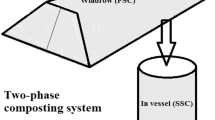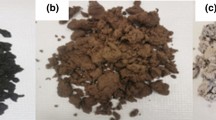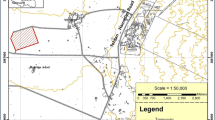Abstract
The compostability of water-based paint sludge originating from the automotive industry was investigated. Six reactors were operated. Wastewater treatment sludge from the same industry was used as additional substrate, and corncob was used as a bulking agent. The level of paint sludge within the compost mixtures varied between 55 and 85%. All reactors yielded a temperature increase up to thermophilic phase levels (> 40 °C) for a minimum of 5 days, and organic matter and C/N losses were observed. BTEX concentrations decreased during composting. Nickel and tin levels in the final product exceeded the legal compost limits. The calorific value of the compost mixtures increased from 9532 to 18774 kJ/kg at the end of the composting process. It was seen that the process applied in this study can be utilized as a biodrying step before the usage of paint sludge at cement kilns as additional fuel.




Similar content being viewed by others
References
Papasavva S, Kia S, Claya J, Gunther R (2002) Life cycle environmental assessment of paint processes. J Coat Technol 74:65–76
Salihoglu G, Salihoglu NK (2016) A review on paint sludge from automotive industries: generation, characteristics and management. J Environ Manag 169:223–235
Zhang L, Sun XY (2016) Influence of bulking agents on physical, chemical, and microbiological properties during the two-stage composting of green waste. Waste Manag 48:115–126
Zhu NW (2006) Composting of high moisture content swine manure with corncob in a pilot-scale aerated static bin system. Biores Technol 97:1870–1875
Tian YQ, Chen LM, Gao LH, Michel FC, Keener HM, Klingman M et al (2012) Composting of waste paint sludge containing melamine resin and the compost’s effect on vegetable growth and soil water quality. J Hazard Mater 243:28–36
Tian YQ, Chen LM, Gao LH, Michel FC, Wan CX, Li YB et al (2012) Composting of waste paint sludge containing melamine resin as affected by nutrients and gypsum addition and microbial inoculation. Environ Pollut 162:129–137
Tian YQ, Chen LM, Wu ML, Gao LH, Michel FC, Dick WA (2015) Windrow composting of waste paint sludge containing melamine resins. Compost Sci Util 23:199–206
Ucaroglu S (2014) Use of sunflower stalks as a bulking agent in sewage sludge composting. Fresen Environ Bull 23:1302–1308
Ucaroglu S, Alkan U (2016) Composting of wastewater treatment sludge with different bulking agents. J Air Waste Manag 66:288–295
Nelson DW, Sommers LE (1982) Total carbon, organic carbon and organic matter. In: Page AL, Miller RH, Keeney DR (eds) Methods of soil analysis, part 2. Chemical and microbiological properties. ASA and SSSA, Agronomy Monograph No. 9, Madison, pp 539–577
Bremner JM, Mulvaney CS (1982) Nitrogen-total. In: Page AL, Miller RH, Keeney DR (eds), Methods of soil analysis, part 2. Chemical and microbiological properties. ASA and SSSA, Agronomy Monograph No. 9, Madison, pp 595–624
Keeney DR, Nelson DW (1982) Nitogen-inorganic forms. In: Page AL, Miller RH, Keeney DR (eds) Methods of soil analysis, part 2. Chemical and microbiological properties. ASA and SSSA, Agronomy Monograph No. 9, Madison, pp 643–698
APHA (1998) Standard methods for the examination of water and wastewater. APHA–AWWA–WPCF, Washington, DC
Barrington S, Choiniere D, Trigui M, Knight W (2002) Effect of carbon source on compost nitrogen and carbon losses. Biores Technol 83:189–194
Diaz LF, Savage GM, Eggerth LL, Golueke GG (1993) Composting and recycling, municipal solid waste. CRC Publishers, Boca Raton
Khalil AI, Hassouna MS, El-Ashqar HMA, Fawzi M (2011) Changes in physical, chemical and microbial parameters during the composting of municipal sewage sludge. World J Microbiol Biotechnol 27:2359–2369
Okalebo JR, Gathua KW, Woomer PL(1993) Laboratory methods of soil and plant analysis: a working manual, TSBF programe. Soil Science Society of East Africa technical publication, no. 1, UNESCO, Rosta
Madejon E, Diaz MJ, Lopez R, Cabrera F (2002) New approaches to establish optimum moisture content for compostable materials. Biores Technol 85:73–78
Nikaeen M, Nafez AH, Bina B, Nabavi BF, Hassanzadeh A (2015) Respiration and enzymatic activities as indicators of stabilization of sewage sludge composting. Waste Manag 39:104–110
Bernal MP, Alburquerque JA, Moral R (2009) Composting of animal manures and chemical criteria for compost maturity assessment. A review. Biores Technol 100:5444–5453
Cui EP, Wu Y, Zuo YR, Chen H (2016) Effect of different biochars on antibiotic resistance genes and bacterial community during chicken manure composting. Biores Technol 203:11–17
Bertoldi M, Vallini G, Pera A (1983) The biology of composting: a review. Waste Manag Res 1:157–176
USEPA (1993) Standards for the use and disposal of sewage, 40 CFR Parts 257, 403, and 503 (FRO-4203-3), final rule, Fed. Register, 58, 9248. US Government Printing Office, Washington, DC
Haug RT (1993) The practical handbook of compost engineering. CRC Publishers Ltd., Boca Raton
Kulikowska D (2016) Kinetics of organic matter removal and humification progress during sewage sludge composting. Waste Manag 49:196–203
MoEU (2015) Compost notification. Republic of Turkey, Ministry of Environment and Urbanization, Official Gazette, No. 29286, Date: 5 March 2015
Amir S, Hafidi M, Merlina G, Revel JC (2005) Sequential extraction of heavy metals during composting of sewage sludge. Chemosphere 59:801–810
El-Naas MH, Acio JA, El-Telib AE (2014) Aerobic biodegradation of BTEX: progresses and prospects. J Environ Chem Eng 2:1104–1122
Mathur AK, Balomajumder C (2013) Biological treatment and modeling aspect of BTEX abatement process in a biofilter. Biores Technol 142:9–17
Cai L, Chen TB, Gao D, Zheng GD, Liu HT, Pan TH (2013) Influence of forced air volume on water evaporation during sewage sludge bio-drying. Water Res 47:4767–4773
Winkler MKH, Bennenbroek MH, Horstink FH, van Loosdrecht MCM, van de Pol GJ (2013) The biodrying concept: an innovative technology creating energy from sewage sludge. Biores Technol 147:124–129
Acknowledgements
The authors are grateful to B. Gamze Gumrah, Ecem Ozdemir, Nihan Aygun, Saban Pekacar, Dila Ates, and Busra Ozak for their experimental efforts. The authors would like to acknowledge the financial support of Uludag University with project numbers: OUAP (M)-2013/8 and OUAP (M)-2009/19.
Author information
Authors and Affiliations
Corresponding author
Rights and permissions
About this article
Cite this article
Salihoglu, N.K., Ucaroglu, S. & Salihoglu, G. Bioconversion of industrial wastes: paint sludge from automotive manufacturing. J Mater Cycles Waste Manag 20, 2100–2109 (2018). https://doi.org/10.1007/s10163-018-0764-z
Received:
Accepted:
Published:
Issue Date:
DOI: https://doi.org/10.1007/s10163-018-0764-z




